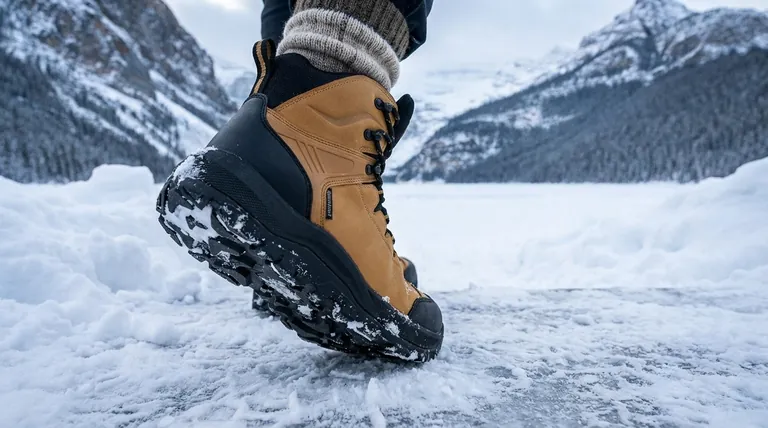Layering socks is not about adding bulk; it's about creating a high-performance system for your feet. The method works by combining a thin, moisture-wicking liner sock with a thicker, insulating outer sock. This two-part system traps warm air while actively moving sweat away from your skin, keeping your feet both warm and dry in extreme conditions.
The most critical function of layering socks is not just warmth, but moisture management. A dry foot is a warm foot, and a two-layer system is the most effective way to pull sweat off the skin and trap insulating air.

The Two-Part System: A Scientific Approach
To understand why layering is so effective, you must see it as two components working together, each with a distinct and vital job.
The Liner Sock: Your Moisture Manager
The layer directly against your skin has one primary responsibility: to wick moisture away. Your feet sweat even in the cold, and that moisture is a rapid conductor of heat.
A thin liner sock made of merino wool or a synthetic material acts like a pipeline, pulling sweat from your skin and pushing it to the outer sock. This keeps your skin's surface dry.
The Insulating Sock: Your Heat Trap
The second, thicker sock is your insulation. Its job is to create loft and trap air. This layer is almost always made of a thicker wool, especially merino.
Wool is a superior insulator because its natural crimp creates thousands of tiny air pockets. It also has the critical ability to retain its insulating properties even when damp, continuing to keep you warm after absorbing moisture from the liner sock.
The Physics of Trapped Air
The real insulator in this system is not the fabric itself, but the air trapped within it. Air is a very poor conductor of heat.
By using two layers, you create a pocket of still air between the liner and the outer sock. This, combined with the air trapped in the wool fibers of the outer sock, creates a significant thermal barrier that your body heat warms up and maintains.
Common Pitfalls and Critical Trade-offs
Simply adding more socks is often counterproductive. The effectiveness of this system depends on avoiding common mistakes.
The Danger of "Too Much"
Using layers that are too thick for your boots is a critical error. This compresses the sock fibers, eliminating the trapped air pockets and destroying their insulating value.
Furthermore, excessive tightness restricts blood flow to your feet. Reduced circulation means less warm blood reaches your extremities, causing your feet to become cold regardless of your socks.
The Mistake of Using Cotton
Never use a cotton sock as any part of your layering system. Cotton is highly absorbent and loses all of its insulating properties the moment it gets wet.
A damp cotton sock will actively pull heat away from your foot, accelerating heat loss and dramatically increasing the risk of cold-related injury.
Boot Fit is Paramount
Your layering system will fail if your boots are too small. You must have enough room in your footwear to accommodate both sock layers without causing pressure or restricting circulation.
Always try on winter boots while wearing the specific sock combination you plan to use in the field.
Making the Right Choice for Your Goal
Your activity level dictates the ideal combination of materials.
- If your primary focus is high-exertion activity (like winter hiking or skiing): Prioritize a thin synthetic liner for maximum moisture-wicking, paired with a mid-weight wool sock to balance warmth and prevent overheating.
- If your primary focus is stationary activity (like ice fishing or winter camping): Opt for a thin merino wool liner for its initial warmth and a thick, heavy-weight wool sock for maximum heat retention.
A well-executed layering system transforms your footwear from a simple covering into a climate-control system for your feet.
Summary Table:
| Layer | Primary Function | Recommended Material |
|---|---|---|
| Liner Sock | Wicks moisture away from skin | Merino Wool, Synthetic |
| Insulating Sock | Traps air for warmth; retains heat when damp | Thick Merino Wool |
Ready to equip your customers with high-performance footwear systems?
As a large-scale manufacturer, 3515 produces a comprehensive range of durable and technical footwear for distributors, brand owners, and bulk clients. Our production capabilities encompass all types of insulated boots and shoes designed for extreme conditions, ensuring your customers stay warm, dry, and protected.
Contact our expert team today to discuss your manufacturing needs and deliver superior quality.
Visual Guide

Related Products
- Premium Insulated Safety Boots and Shoes for Wholesale & Bulk Orders
- Safety Footwear Wholesale Manufacturer for Custom OEM/ODM Production
- Durable Rubber-Soled Utility Shoes for Wholesale & Custom Brand Manufacturing
- Wholesale Breathable Training Shoes Custom Athletic Footwear Manufacturer
- Wholesale Modern Comfort Shoes with Dial Closure for Private Label & Bulk Orders
People Also Ask
- Why is keeping feet warm important during winter work? Protect Your Health and Safety on the Job
- Can insulated work boots be worn in warmer weather? Avoid Discomfort and Foot Health Risks
- What features should one look for when selecting supportive winter footwear? Secure Your Stride with the Right Support
- What is Thinsulate and how does it function in insulated boots? Achieve Superior Warmth Without Bulk
- Why is it important to keep feet warm in winter? Protect Your Health & Circulation



















